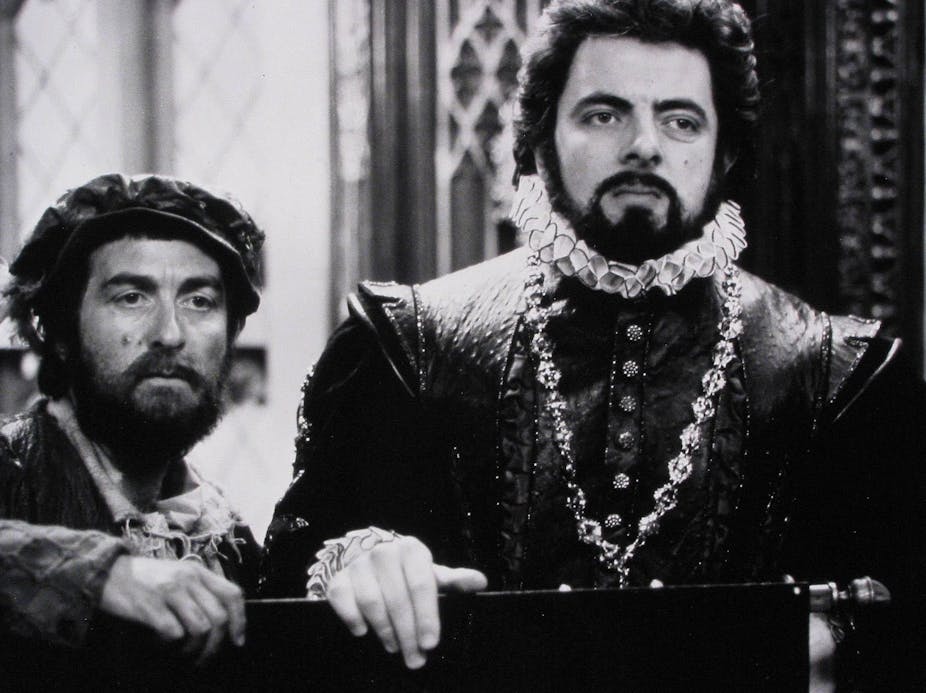As part of this year’s 40th anniversary celebrations of Blackadder, the classic historical BBC comedy series, the pilot episode from 1982 aired for the first time in years on Gold. It’s been hitherto kept under wraps, never broadcast or released on DVD. Why? It’s because it’s simply not Blackadder as we know it.
In a classic episode, you want Blackadder to be a scheming, conniving character who has a hopeless, dimwitted underling named Baldrick and a domineering but clueless master above him. Except it didn’t start that way.
I spoke about the pilot with Lucy Lumsden, boss of Yellow Door Productions and former Head of BBC TV Comedy Commissioning, for a book I am in the process of writing on comedy. Lumsden agrees the pilot is all over the place.
Played by Philip Fox, Baldrick is not yet the fool he was to become. He’s slightly useless, as Lumsden notes, “but you’ve got to pull hard in the opposite direction. You want Baldrick to be the total opposite of Blackadder”.
As a writer, if you really embrace the idea of opposites, all you need is one strong, clearly defined character. Then for your next character you just go to the complete opposite of this first one. And now suddenly, you’ve got another good character and the two of them are going to be really funny together.
At least Blackadder is exactly as we want him to be – smart, cynical, sarcastic.
And yet, as Lucy observes, in the pilot, “Blackadder, the character that’s absolutely going to draw the eye and you’ll want to just spend every scene with, doesn’t appear for five minutes! As a viewer, I don’t know where my attention should go in that pilot”.
If you didn’t know otherwise, you’d probably think the protagonist was Robert Bathurst’s Prince Harry character who is alongside the queen in the opening scene. Note to writers: unless there is an absolutely compelling reason not to, introduce us to your brilliant protagonist right away.
Nevertheless, Blackadder is his cynical self in the pilot, so at least they have that to build on as they go into series one, right? No, they throw away the one thing that was working about the pilot and instead of being witty and cutting, in the first series Blackadder becomes a Baldrick-style fool.
Baldrick meanwhile, although now played by Tony Robinson, is at this point the smarter one. It’s like coming across an early Jeeves and Wooster novel where Bertie Wooster is level headed and mature and Jeeves is an idiot.
But happily following the pilot and the misfiring first series, they got another chance and the Blackadder we know and love was born.
A trusted comedic structure
With a smaller budget than series one, no on location filming and a new writing team (Ben Elton now writing with Richard Curtis), series two returned to Elizabethan times. The domineering master is still Elizabeth I but Elspet Gray’s rather dull queen is replaced by Miranda Richardson doing her now legendary shriekingly childish performance.
You have the return of the cynical Blackadder from the pilot. With the crazy Queen Elizabeth above him and the – at last – stupid Baldrick below him, you have an ensemble that works.
As I write in my book Creating Comedy Narratives for Stage and Screen, the classic shape of an ensemble of comedic characters is what I term the boss, striver, fool dynamic.
The boss is the one who is in charge by dint of their role, position in the family or simply because they are the alpha figure. The key to the comedy though is that they are dysfunctional boss figures.
At the opposite end is the self-explanatory fool and stuck in the middle is the protagonist, the striver. Being stuck in the middle is the plight of scores of sitcom characters. They are sitcom’s dreamers. Aspiring to a better life, free of their bookends.
So many sitcoms have this dynamic at their heart, or as part of a wider ensemble. It’s the Sybil, Basil and Manuel of Fawlty Towers. Or the Martin Crane, Frasier and Niles in Fraiser (your fool can be intelligent, what makes them a fool can be their lack of self-awareness or naivety or social awkwardness).
Seasons of bosses, strivers and fools
Blackadder is an interesting case to consider with it’s shifting cast of characters from series-to-series. As we’ve seen, in the first Blackadder, he himself was the fool which is unusual for a central character but he was shifted to striver for series two, with the boss Queen Elizabeth I and the fool Baldrick (and Percy).
In Blackadder the third, set during the Georgian era, Mr. E. Blackadder is a butler to the Prince Regent. Baldrick the fool is Blackadder’s dogsbody. Here Blackadder is of course the striver, the boss became the Prince Regent.
Transported to the trenches of the first world war, Blackadder Goes Forth doubles up all the slots with General Melchett and Field Marshall Haig as bosses. In the striver slot we have Blackadder again, alongside his antagonist Captain Darling. Fools also double up with Baldrick and George, one working class and one upper class.
Looking back to that first season 40-years-ago, it is odd to think that such a beloved comedy could initially have got it so very wrong. While Blackadder was afforded the kind of trial and error that would be unheard of today, for today’s new comedy writers it can be encouraging to see that even masterpieces can have a difficult birth.

Looking for something good? Cut through the noise with a carefully curated selection of the latest releases, live events and exhibitions, straight to your inbox every fortnight, on Fridays. Sign up here.

